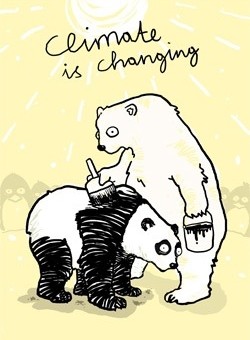 Gray-overcast and cold this early Tuesday on California’s north coast as a ‘atmospheric river event‘ is supposedly coming later today.
Gray-overcast and cold this early Tuesday on California’s north coast as a ‘atmospheric river event‘ is supposedly coming later today.
Seemingly, we’re living a nightmare-360 scenario — according to a new study, methane (CH4), a powerful greenhouse gas, a contributor to climate change (more potent greenhouse gas, trapping 28 times more heat than CO2), is rising faster in the atmosphere than any other time in the past 20 years. And researchers don’t seem to know why.
Rob Jackson, an earth scientist at Stanford explains the summary (iTechPost):
“Methane concentrations in the atmosphere were pretty stable in the 2000s. But in the last decade they’ve gone up ten times faster than they did in 2000-2006, and they’ve gone up faster still in 2014-15.”
(Illustration by Handoko Tjung, found here).
Of course, the major culprit with global warming is CO2,though, reportedly, the world is catching a break here, there’s been no growth in annual CO2 emissions for the past three years.
Supposedly, 60-percent of the CH4 rise since 2006 has come from agriculture, about one-third from oil and gas operations.
Some details of the study via the BBC yesterday — a fright is not knowing how shitty a shitty thing:
Quite why methane has suddenly spiked is not obvious.
After barely moving between 2000 and 2006, the concentration in the atmosphere ticked upwards from 2007, and then jumped sharply in 2014 and 2015.
In those final two years, methane rose rapidly by 10 or more parts per billion (ppb) annually.
It is now just above 1,830ppb.
By contrast, global CO2 emissions have flattened somewhat of late, giving hope that the rise in its atmospheric concentration (currently just above 400 parts per million) might also slow.
“Methane has many sources, but the culprit behind the steep rise is probably agriculture,” Prof Jackson told BBC News.
“We do see some increased fossil fuel emissions over the last decade, but we think biological sources, and tropical sources, are the most likely.”
Agricultural sources would include cattle and other ruminants, as well as rice paddies.
…
CH4 is about 30 times better than CO2, over a century timescale, at trapping heat in the atmosphere.
Scientists use computer models to try to project how Earth will warm given a certain mix of gases, and right now methane’s growth rate is close to a path that would take the world into a very challenging future.
“If we want to stay below two degrees temperature increase, we should not follow this track and need to make a rapid turn-around,” said Dr Marielle Saunois from the University of Versailles Saint Quentin, France.
She is the lead author on the ERL paper.
Run away, run away…